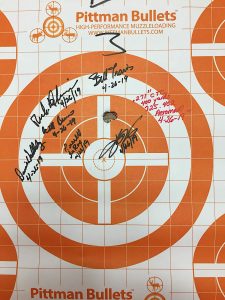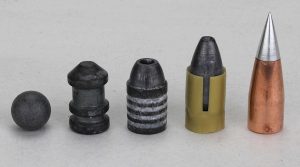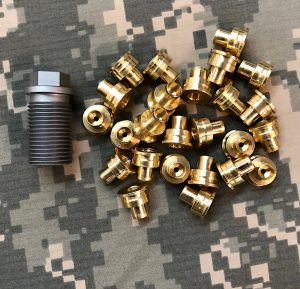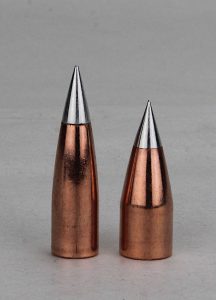By Art Merrill
With muzzleloading firearms, every load is a handload.
Even so, muzzleloaders aren’t a popular subject for reloading articles as, let’s face it, muzzleloaders don’t utilize reloadable cartridges.
Prepare to change your perspective.
Still around

A 400 yard .271” group fired from a Hankins smokeless powder muzzleloader with Pittman bullets.
Curiously, the muzzleloader hasn’t faded into history, though two of its earlier ignition systems – the matchlock and wheel lock – are so rare at the range or in the field that you’ve probably never encountered one. Military leaders of many countries welcomed breech loading cartridge arms, and one would expect that cartridge arms would have sent muzzleloaders down the same road as computer punch cards. But precision target shooters of the day insisted no breech loader could ever match a muzzleloader for accurate shooting, and a significant number of subsistence hunters kept their flint and percussion muzzleloading rifles well into the 20th Century as a matter of economics.
Historical interest has kept flintlock and percussion lock muzzleloaders on the shooting scene. For example, muzzleloader collector Kirkland Turner founded Dixie Gun Works decades ago, and though he is gone his company still enjoys considerable success in selling new-manufactured muzzleloaders based on original designs, as well as parts and DIY kit guns. A viable American cottage industry of specialist gunsmiths provides true-to-original parts to muzzleloading enthusiast. “Mountain man” and other historical re-enactors abound, and rendezvous and skirmish events remain popular.
Short legs
Traditional style muzzleloaders can shoot as accurately and precisely as many a modern smokeless powder rifle, but with a caveat: they can do so only at comparatively short range. This drawback is a function of both the propellant and the projectile. In his Muzzleloading Notebook, Sam Fadala, dean of shooting traditional style muzzleloaders, said a “whopper load” of 110 grains of FFg black powder, safe in his test rifle, drove a 177-grain .50-caliber ball at 2,000 fps. In further testing to find the limits of black powder, he discovered that in increasing the load to 200 grains of FFg – AN UNSAFE LOAD IN ANY RIFLE AND WHICH YOU SHOULD NOT ATTEMPT TO DUPLICATE! – the “velocity went up very little beyond the 110 grain load.” He also discovered a point at which increasing the powder charge even further actually caused a reduction in velocity.

Projectile chronology: round ball, conical, factory dry-lubed conical, sabot round, Pittman bullet for smokeless powder.
Round balls lose velocity rapidly; a .50-caliber ball started at 2,000 fps has lost about half its velocity at 100 yards. Switching to a 385 grain conical ball helps. Started at 1,500 fps, the conical is still moving at 1,100 fps at 100 yards, plus it retains about 1,000 foot-pounds of energy, compared to the round ball’s 475 foot-pounds. Given the generally accepted rule that a projectile should have about 1,000 foot-pounds of striking energy to reliably down a deer, the muzzleloader’s range limitation becomes obvious. While traditional black powder muzzleloaders can be coaxed to shoot one-hole groups at 200 yards (witness Scheutzen competition, which later utilized black powder cartridges but were still often loaded from the muzzle), velocities are well below the hunting threshold. Precision falls off with velocity beyond that distance: at the early 1,000-yard Creedmoor competitions in the late 1800s, the bullseye was 36 inches across and groups measured in feet.
Improving hunt performance
Despite their limitations, the undying and resurgent interest in muzzleloaders led many states to adopt a muzzleloading deer hunting season to precede the “regular” hunting season; the arrangement acknowledges that muzzleloaders have a significant disadvantage in range compared to modern rifles, typically around 100 to 200 yards. However, ever since the widespread adoption of a separate muzzleloading season, inventors and aficionados have been nibbling away at that range limitation.

Primer modules hold Boxer primers and seal the breech against gas pressure.
The first commercial shot at extending the muzzleloader’s range, back in the 1970s as I recall, was to mount a scope on the rifle. The muzzleloader hunting season continued to drive manufacturers to improve muzzleloader performance with the pursuit of modern muzzleloader in-line ignition systems utilizing shotgun 209 primers. Manufacturers designed improved conical bullets and lubes, and then introduced the plastic sabot for hunters to shoot sub-caliber, expanding jacketed bullets from their muzzleloaders – for example, a .45 caliber pistol bullet in a .50 caliber rifle.
Hodgdon developed Pyrodex, a black powder substitute that is safer than black powder to ship, store and handle. Then, for faster reloading Pyrodex became available in pellet form. A couple of years ago at SHOT Show, Western Powders introduced their Blackhorn 209 substitute black powder, intended specifically for inline muzzleloaders shooting plastic sabot bullets sparked by 209 primers. Muzzleloader performance has much-improved to the point that some states permit only traditional style muzzleloaders during muzzleloader season.
Smokeless muzzleloaders
To this point, we’ve been considering “muzzleloader” to be synonymous with “black powder” and black powder substitutes and their limitations, despite the use of sabots and jacketed bullets. However, modern engineering now makes this assumption erroneous. Today’s cutting edge muzzleloading rifles and projectiles bear zero resemblance to traditional muzzleloaders. Black powder and Pyrodex are passé, as these guns burn modern smokeless rifle powders. Ignition is via Boxer large rifle primers held in a device that’s rather like a cartridge case head. Bullets are about as space-age as it gets, with those from Pittman Bullets resembling the warheads of MX ballistic missiles.

Except for the ramrod, the Hankins High Performance Smokeless muzzleloader is indistinguishable from a modern long range rifle.
Hankins Custom High Performance Muzzleloaders makes these phenomenal smokeless powder muzzleloaders on an individual basis; the design key is the Hankins Ignition System. Gunsmith Jeff Hankins utilizes removable “primer modules” that help ensure a gas-tight seal at the breech; Jeff says each module is good for about 25 or more firings, and he provides 25 modules with each custom rifle. Jeff builds his high performance smokeless powder muzzleloaders on bolt actions (he recommends the Remington Model 700 action), and on them you can have every custom feature that you might order for any cartridge rifle.
The second necessary component is the specialized projectile. Pittman Bullets provides these; though of ostensible .40 and .45-caliber, the shooter first swages each jacketed bullet to precisely fit his individual Hankins barrel. Pittman bullets are flat based, long in the nose and short in the shank; the needle-sharp point is a separate piece of lathe-turned aircraft grade aluminum. A custom copper jacket surrounds a Pittman original pure lead core. Four Pittman Bullet offerings cover target and hunting applications: 250-grain and 312-grain bullets for .40-caliber, and 300- and 325-grainers for .45-caliber. Performance on targets is equal to that of purpose-built precision cartridge rifles; while practicing for the 10th Kentucky Challenge competition in April this year, Pittman Bullets owner Kyle Pittman fired a .271-inch group at 400 yards with his bullet in a Hankins heavy bench rest rifle.
Smokeless load

L-R, Pittman .40 caliber 312-gr Aeromax and .45-caliber 325-gr Accumax. Tips are lathe-turned aluminum.
WARNING: Never use smokeless powder in any production muzzleloader! Doing so can cause serious injury or death in the event of a burst barrel or ignition system components that fail catastrophically under high pressure. The following information is specific to one individual barrel gunsmithed by Hankins Custom High Performance Muzzleloaders, owned by bullet maker Kyle Pittman and firing Pittman bullets.
Kyle provided data for one load he uses in his .45-caliber Hankins rifle: a 275 grain Pittman AccuMax .452″ bullet and 78 grains IMR 4198, producing 3018 fps muzzle velocity and an impressive 5513 ft.-lbs. of muzzle energy. The scoped rifle, incidentally, weighs 15 pounds, 6 ounces.
“This is the type of performance we are getting with our heavily built high performance smokeless muzzleloaders with the Hankins Ignition System,” Kyle said. “By no means should any smokeless powder be used in any off-the-shelf production type muzzleloader. Pittman Bullets make no claims that this load is to be used in any muzzleloading firearm. This load is what I shoot in my gun and I feel safe doing so. I provide the information only to demonstrate the capabilities of high performance smokeless muzzleloading.”
New perspective
Hunters, too, are reaching out with the Hankins/Pittman combo, claiming big game in testimonials on the Pittman Bullets website (below) at ranges unthinkable with black powder muzzleloaders.
As handloaders, we’re not off the mark if we consider the high performance smokeless muzzleloader itself to be the reusable cartridge case that holds the powder charge, bullet and primer. The only remaining traditional aspect of these muzzleloaders is the powder and bullet going down the muzzle; whether such rifles that take deer at 800 yards should qualify for their own early hunting season is something for the individual to argue with his or her state’s wildlife agency. Regardless, for the handloader the high performance smokeless muzzleloader is a viable venue because, after all, every load is still a handload.
For a quick education in high performance smokeless muzzleloaders, visit www.pittmanbullets.com. Check out gunsmith Jeff Hankins’ high performance smokeless muzzleloaders at www.hankinscustomrifles.com.



